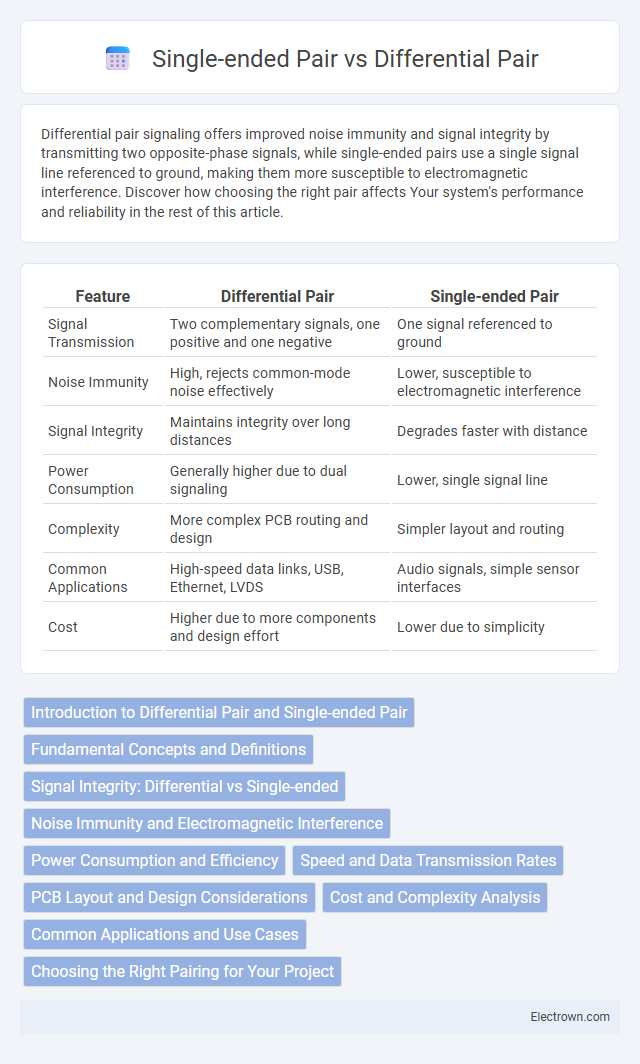Differential pair signaling offers improved noise immunity and signal integrity by transmitting two opposite-phase signals, while single-ended pairs use a single signal line referenced to ground, making them more susceptible to electromagnetic interference. Discover how choosing the right pair affects Your system's performance and reliability in the rest of this article.
Table of Comparison
| Feature | Differential Pair | Single-ended Pair |
|---|---|---|
| Signal Transmission | Two complementary signals, one positive and one negative | One signal referenced to ground |
| Noise Immunity | High, rejects common-mode noise effectively | Lower, susceptible to electromagnetic interference |
| Signal Integrity | Maintains integrity over long distances | Degrades faster with distance |
| Power Consumption | Generally higher due to dual signaling | Lower, single signal line |
| Complexity | More complex PCB routing and design | Simpler layout and routing |
| Common Applications | High-speed data links, USB, Ethernet, LVDS | Audio signals, simple sensor interfaces |
| Cost | Higher due to more components and design effort | Lower due to simplicity |
Introduction to Differential Pair and Single-ended Pair
Differential pairs consist of two conductors carrying equal and opposite signals, providing noise immunity and improved signal integrity in high-speed data transmission. Single-ended pairs use a single conductor referenced to a common ground, making them simpler but more susceptible to electromagnetic interference. The choice between differential and single-ended pairs impacts signal quality, crosstalk, and overall performance in electronic circuits.
Fundamental Concepts and Definitions
Differential pairs consist of two complementary signals transmitted over two conductors, enabling noise cancellation and improved signal integrity, while single-ended pairs use a single conductor referenced to a common ground, making them simpler but more susceptible to interference. Differential signaling relies on the voltage difference between the pair, reducing electromagnetic interference and crosstalk, crucial for high-speed data transmission. Ensuring your design incorporates differential pairs can significantly enhance performance in noisy environments compared to single-ended configurations.
Signal Integrity: Differential vs Single-ended
Differential pairs offer superior signal integrity compared to single-ended pairs by minimizing electromagnetic interference and crosstalk through balanced, opposite polarity signals. This inherent noise rejection improves data transmission reliability in high-speed digital and RF circuits. Your designs benefit from enhanced signal quality and reduced error rates when using differential signaling over single-ended connections.
Noise Immunity and Electromagnetic Interference
Differential pairs offer superior noise immunity by transmitting signals as opposite polarities, effectively canceling out common-mode noise and reducing susceptibility to electromagnetic interference (EMI). Single-ended pairs, with one signal referenced to ground, are more prone to noise and EMI because external interference directly influences the signal voltage. This makes differential signaling the preferred choice in high-speed or electrically noisy environments to ensure signal integrity.
Power Consumption and Efficiency
Differential pairs consume less power compared to single-ended pairs due to their ability to reject common-mode noise, reducing the need for additional signal amplification and filtering. This rejection enhances overall system efficiency by minimizing signal distortion and power loss in transmission lines. Single-ended pairs often struggle with noise interference, leading to higher power consumption for error correction and signal integrity maintenance.
Speed and Data Transmission Rates
Differential pairs enable higher data transmission rates due to their improved noise immunity and signal integrity compared to single-ended pairs, which are more susceptible to electromagnetic interference. The balanced nature of differential signaling reduces crosstalk and electromagnetic emissions, allowing reliable operation at frequencies exceeding multiple gigabits per second. Single-ended pairs, limited by their exposure to noise and signal degradation, generally support lower speed transmissions suitable for simpler, less noise-sensitive applications.
PCB Layout and Design Considerations
Differential pair routing in PCB layout requires tightly controlled impedance and consistent spacing to minimize noise and crosstalk, ensuring signal integrity at high frequencies. Single-ended pairs demand less stringent matching but are more susceptible to electromagnetic interference and ground noise, impacting performance in sensitive designs. Your PCB design should prioritize differential pairs for high-speed data transmission to achieve better noise immunity and signal quality.
Cost and Complexity Analysis
Differential pairs typically incur higher costs due to the need for matched impedance traces and specialized components, increasing PCB design complexity and manufacturing requirements. Single-ended pairs are more cost-effective with simpler routing and fewer constraints, ideal for budget-sensitive projects with less critical noise immunity. Your choice depends on balancing performance demands against cost and complexity in your electronic design.
Common Applications and Use Cases
Differential pairs are widely used in high-speed data communication interfaces such as USB, HDMI, and Ethernet, where noise immunity and signal integrity are critical. Single-ended pairs commonly appear in simpler, lower-speed applications like analog audio signals, sensor connections, and basic digital logic lines. Choosing the appropriate method depends on your design requirements for noise reduction, signal fidelity, and transmission distance.
Choosing the Right Pairing for Your Project
Choosing the right pairing depends on your project's sensitivity to noise and signal integrity requirements. Differential pairs offer superior noise immunity and reduced electromagnetic interference, making them ideal for high-speed or long-distance communication. Single-ended pairs are simpler and cost-effective for short-distance or low-frequency signals where noise is less critical.
Differential Pair vs Single-ended Pair Infographic

 electrown.com
electrown.com